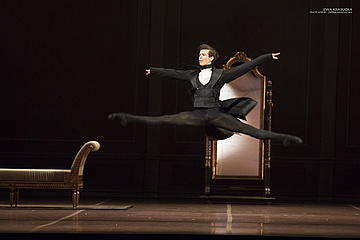The Lady of the Camellias
Fryderyk Chopin / John Neumeier
-
Act 1
ca. 40 min.
-
Intermission
25 min.
-
Act 2
ca. 40 min.
-
Intermission
25 min.
-
Act 3
ca. 50 min.
Duration: ca. 3 hrs
- See photo: 1. Chinara Alizade & Vladimir Yaroshenko, photo by Ewa Krasucka

- See photo: 2. Yuka Ebihara & Patryk Walczak, photo by Ewa Krasucka IMG_6054

- See photo: 3. Kristóf Szabó, photo by Ewa Krasucka

- See photo: 4. Yuka Ebihara & Patryk Walczak, photo by Ewa Krasucka IMG_8287

- See photo: 5. Chinara Alizade & Vladimir Yaroshenko, photo by Ewa Krasucka

- See photo: 6. Yuka Ebihara & Patryk Walczak, photo by Ewa Krasucka

- See photo: 7. Chinara Alizade & Wojciech Ślęzak, photo by Ewa Krasucka

- See photo: 8. Natalia Pasiut & Carlos Martín Pérez, photo by Ewa Krasucka Pérez

- See photo: 9. Chinara Alizade, photo by Ewa Krasucka

- See photo: 10. Yuka Ebihara & Patryk Walczak, photo by Ewa Krasucka

- See photo: 11. Chinara Alizade & Vladimir Yaroshenko, photo by Ewa Krasucka

- See photo: 12. Kristóf Szabó, photo by Ewa Krasucka

- Featuring Yuka Ebihara's Farewell Performance
Ballet in three acts with a prologue by John Neumeier after the novel by Alexandre Dumas, fils
Premiere: 4 November 1978, Stuttgarter Ballett
Polish premiere: 20 April 2018, Teatr Wielki – Polish National Opera, Warsaw
For adults only
Alexandre Dumas fils in his La Dame aux Camélias describes a refined variant of personal love for a Parisian courtesan. Love, let us add, quite brief in duration and cut short by Alexandre Dumas père, and ultimately by his beloved’s death of consumption. It began with a novel, later a play appeared, followed by a migration of the tragic heroine to Verdi’s La traviata, for the story to finally become the theme of the famous ballet by the remarkable choreographer John Neumeier. He opted to use Chopin’s music (although initially he considered Verdi). I do not know if he knew at the time that Dumas fils ended up in Mysłowice in 1851 while searching for another paramour of his (a daughter-in-law of the Russian Chancellor), where he took up the case of a mysterious murder to while away the time. He never got to see his mistress, never found the murderer, but he did stumble upon George Sand’s letters to Frédéric Chopin instead. The paths of Dumas and Chopin crossed once in Silesia, and now they do yet again in Warsaw, in Neumeier’s exceptional La Dame aux Camélias. The power of modern classics on stage and historical flavours off stage.
Cast
-
- Marguerite Gautier
- Armand Duval
- Monsieur Duval
- Nanina
- The Duke
- Prudence Duvernoy
-
- Gaston Rieux
- Manon Lescaut
- Kawaler des Grieux
- Olympia
- Count N.
-
- Marguerite Gautier
- Armand Duval
- Monsieur Duval
- Nanina
- The Duke
- Prudence Duvernoy
-
- Gaston Rieux
- Manon Lescaut
- Kawaler des Grieux
- Olympia
- Count N.
-
- Marguerite Gautier
- Armand Duval
- Monsieur Duval
- Nanina
- The Duke
- Prudence Duvernoy
-
- Gaston Rieux
-
Manon Lescaut
-
Kawaler des Grieux
 Ivan Pal
Ivan Pal
(debuting in the role) -
Olympia
 Nika Afonina
Nika Afonina
(debuting in the role) -
Count N.
-
- Marguerite Gautier
- Armand Duval
- Monsieur Duval
- Nanina
- The Duke
- Prudence Duvernoy
-
- Gaston Rieux
- Manon Lescaut
- Kawaler des Grieux
- Olympia
- Count N.
-
- Marguerite Gautier
- Armand Duval
- Monsieur Duval
- Nanina
- The Duke
- Prudence Duvernoy
-
- Gaston Rieux
-
Manon Lescaut
-
Kawaler des Grieux
 Ivan Pal
Ivan Pal -
Olympia
 Nika Afonina
Nika Afonina -
Count N.
-
- Marguerite Gautier
- Armand Duval
- Monsieur Duval
- Nanina
- The Duke
- Prudence Duvernoy
-
- Gaston Rieux
- Kawaler des Grieux
- Olympia
-
- Marguerite Gautier
- Armand Duval
- Monsieur Duval
- Nanina
- The Duke
- Prudence Duvernoy
-
- Gaston Rieux
-
Manon Lescaut
-
Kawaler des Grieux
 Ivan Pal
Ivan Pal -
Olympia
 Nika Afonina
Nika Afonina -
Count N.
-
- Marguerite Gautier
- Armand Duval
- Monsieur Duval
- Nanina
- The Duke
- Prudence Duvernoy
-
- Gaston Rieux
- Manon Lescaut
- Kawaler des Grieux
- Olympia
- Count N.
Credits
-
- Choreography
-
Music
 Fryderyk Chopin
Fryderyk Chopin - Conductor
- Pianist
- Set and costume designer
- Lighting Conception
-
- Assistant choreographer
-
- Choreography
-
Music
 Fryderyk Chopin
Fryderyk Chopin - Conductor
- Pianist
- Set and costume designer
- Lighting Conception
-
- Assistant choreographer
-
- Choreography
-
Music
 Fryderyk Chopin
Fryderyk Chopin - Conductor
- Pianist
- Set and costume designer
- Lighting Conception
-
- Assistant choreographer
-
- Choreography
-
Music
 Fryderyk Chopin
Fryderyk Chopin - Conductor
- Pianist
- Set and costume designer
- Lighting Conception
-
- Assistant choreographer
-
- Choreography
-
Music
 Fryderyk Chopin
Fryderyk Chopin - Conductor
- Pianist
- Set and costume designer
- Lighting Conception
-
- Assistant choreographer
-
- Choreography
-
Music
 Fryderyk Chopin
Fryderyk Chopin - Conductor
- Pianist
- Set and costume designer
- Lighting Conception
-
- Assistant choreographer
-
- Choreography
-
Music
 Fryderyk Chopin
Fryderyk Chopin - Conductor
- Pianist
- Set and costume designer
- Lighting Conception
-
- Assistant choreographer
-
- Choreography
-
Music
 Fryderyk Chopin
Fryderyk Chopin - Conductor
- Pianist
- Set and costume designer
- Lighting Conception
-
- Assistant choreographer
Polish National Ballet
Orchestra of the Polish National Opera
Synopsis
-
PROLOGUE
The ballet takes place during an auction. The story evolves as a series of memories recalled from various points of view — Armand’s, his Father’s and Marguerite’s.
(All actions during the auction are indicated in bold)
Marguerite Gautier, once the most desirable courtesan in Paris, has died. The complete furnishings of her luxurious apartment are to be disposed of by auction. Carrying Marguerite’s diary, Nanina, her loyal servant, bids the place farewell. Among those inspecting the items is Monsieur Duval, whose son Armand rushes in frantically. Overcome by memories, he collapses.
-
Act I
As Monsieur Duval comforts him, Armand tells his story.
It begins in the Théâtre des Variétés, during a performance of the ballet Manon Lescaut, in which the famous rococo courtesan deceives Des Grieux with numerous admirers. In the audience, Marguerite Gautier is disgusted by Manon’s frivolous in fidelity. Armand Duval, who has long admired Marguerite, is introduced to her by Gaston Rieux. Marguerite makes fun of Armand’s awkward sincerity. As he follows the ballet, Armand fears that his own future may reflect Des Grieux’s sorrowful fate.
After the performance Marguerite invites Armand to her apartment along with his friend Gaston, the courtesan Prudence and her own escort, the wearisome young Count N. Annoyed by the jealous Count, Marguerite suffers a coughing attack. Armand follows her to her bedroom, offers his assistance, then confesses his love. Marguerite is moved by his sincere passion. However, aware of her fatal illness and needing the comfort of luxury, she insists that their affair must remain secret.
While Marguerite continues to lead her hectic life, hastening from one ball to another, from one admirer to the next, from an old Duke to the young Count, Armand is always there — waiting. When Marguerite departs for the idyllic country house the Duke had put at her disposal — he follows her.
-
Act II
Marguerite’s summer straw hat prompts Armand to resume his story...
Surrounded by revealing friends and ardent admirers, Marguerite continues her turbulent life in the country.
With the inevitable confrontation between Armand and the Duke, Marguerite’s moment of decision arrives. She publicly acknowledges her love for Armand. Armand and Marguerite are alone at last.
Armand’s father recalls with regret his part in the story.
Ashamed that his son is living with a prostitute, Monsieur Duval visits Marguerite in the country. He insists that her relationship with his son will ruin Armand. Shocked, Marguerite protests, but the image of Manon and her admirers appear in memory, a mirror image of her own past, confirming the truth of Monsieur Duval’s accusations. He demands that she leave Armand. Out of deep and sincere love Marguerite complies.
Armand tells his father how he found the house deserted.
He waited in vain until Nanina brought him a letter saying that Marguerite had returned to her former life. Unbelieving, Armand runs to Paris, finding Marguerite in the arms of the Duke.
-
Act III
Armand explains to his father how they met later on the Champs-Élysées.
Marguerite was accompanied by the beautiful young courtesan Olympia. To have his revenge on the woman who had so deeply wounded him, Armand flirts with and seduces Olympia.
Deathly ill, Marguerite visits Armand, begging him not to hurt her by flaunting his affair with Olympia. Their passion ignites once more. Falling asleep, a vision of her alter ego Manon beckons Marguerite back to her former life. Waking, she remembers her promise to his father and silently leaves Armand for the second time At a grand ball, Armand publicly humiliates Marguerite by handing her money as payment for past services. Marguerite collapses.
Armand has reached the end of his story. He will never see Marguerite again. Deeply moved, his father leaves, as Nanina returns and gives Armand Marguerite’s diary.
Reading, Armand seems to accompany Marguerite on her last visit to the theatre. Again, she views a scene from the ballet Manon Lescaut. This time it is one in which Manon, impoverished like herself, dies in the arms of her faithful lover Des Grieux.
Ill and despairing, Marguerite leaves the theatre, but the characters from the ballet follow her into a feverish dream. As the phantom lovers blend with her own memories, her identification with Manon seems complete. Deserted and longing to see Armand again, Marguerite confides her last thoughts to the diary, which she gives to Nanina for Armand.
Marguerite dies alone.
Armand silently closes her diary.
Sponsors
-
Ministry of Culture and National Heritage of the Republic of Poland
-
Patrons of the Polish National Opera
Partners of the Opera Academy
-
Partners of the Polish National Opera
-
Partner of the Polish National Ballet
-
Media patrons





![[Translate to English:]](/fileadmin/import/media/img/sezon24_25/dama_kameliowa_tlo_2024.jpg)
![[Translate to English:] [Translate to English:]](/fileadmin/_processed_/2/2/csm_DAMA_KAMELIOWA_-_teaser_b37a4598c4.png)
![[Translate to English:] [Translate to English:]](/fileadmin/_processed_/4/e/csm_DAMA_KAMELIOWA_-_trailer_c75983e481.png)
 Yuka Ebihara
Yuka Ebihara  Patryk Walczak
Patryk Walczak  Wojciech Ślęzak
Wojciech Ślęzak  Joanna Drabik
Joanna Drabik ![[Translate to English:]](/fileadmin/import/uploads/tx_news/Carlos_Martin_Perez_new_02.jpg) Carlos Martín Pérez
Carlos Martín Pérez  Natalia Pasiut
Natalia Pasiut  Paweł Koncewoj
Paweł Koncewoj  Chinara Alizade
Chinara Alizade  Marco Esposito
Marco Esposito Mai Kageyama
Mai Kageyama ![[Translate to English:]](/fileadmin/_processed_/5/9/csm_Bartosz_Zysk_IMG_9055-Edit_-_2025_5eca535a9e.jpg) Bartosz Zyśk
Bartosz Zyśk ![[Translate to English:]](/fileadmin/import/media/img/ludzie/tancerze/medium/Vladimir_Yaroshenko_2024_-_kwadrat.jpg) Vladimir Yaroshenko
Vladimir Yaroshenko  Agnieszka Jankowska
Agnieszka Jankowska Magda Studzińska
Magda Studzińska Diogo de Oliveira
Diogo de Oliveira![[Translate to English:]](/fileadmin/import/media/img/ludzie/tancerze/medium/JAEEUN_JUNG_2024_-_kwadrat.jpg) Jaeeun Jung
Jaeeun Jung  Marko Juusela
Marko Juusela Mar Bonet Sans
Mar Bonet Sans Kristóf Szabó
Kristóf Szabó ![[Translate to English:]](/fileadmin/_processed_/0/d/csm_YANA_SHTANGEI_2025_2_586ab0cef6.jpg) Yana Shtanhei
Yana Shtanhei![[Translate to English:]](/fileadmin/import/media/img/ludzie/tancerze/ryota_kitai_2024_-_kwadrat2.jpg) Ryota Kitai
Ryota Kitai![[Translate to English:]](/fileadmin/_processed_/e/a/csm_John_Neumeier_neu__c__Kiran_West__370_13c7974c06.jpg) John Neumeier
John Neumeier ![[Translate to English:]](/fileadmin/_processed_/b/4/csm_Marta_Kluczynska_fot_karpati_zarewicz_kwadrat_fde347331b.jpg) Marta Kluczyńska
Marta Kluczyńska  Krzysztof Jabłoński
Krzysztof Jabłoński  Marek Bracha
Marek Bracha  Jürgen Rose
Jürgen Rose  Kevin Haigen
Kevin Haigen  Janusz Mazoń
Janusz Mazoń  Radik Zaripov
Radik Zaripov 









